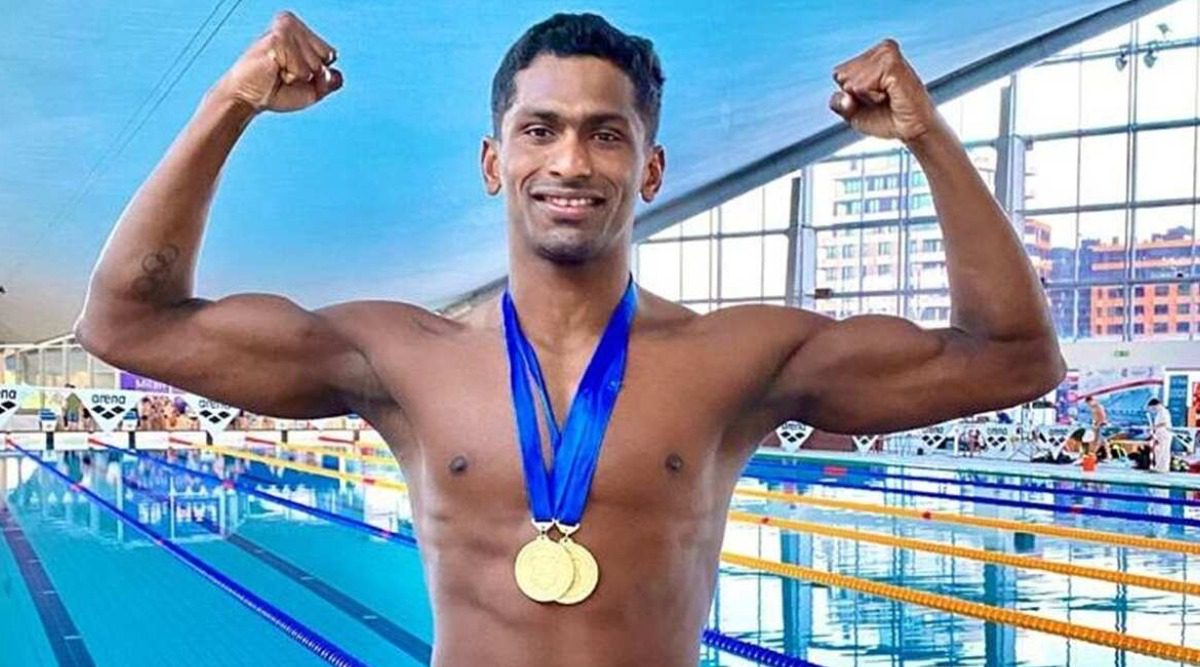(September 5, 2021) Just an hour’s drive away from the hustle and bustle of Chennai is Kovalam, a tiny fishing hamlet that lies along the picturesque East Coast Road. The coastline here is dotted with colorful little homes and fishing boats that are carefully anchored ashore waiting for the fishermen to take them out early the next morning. The air is filled with the smell of the sea – comforting and inviting – as the cool breeze carries with it the sound of laughter and shrieks of kids playing in the crashing waves. It was here that Murthy Megavan, a fisherman-turned-award winning surfer, used to once ride the waves using a discarded wooden window. Today, he is the cool dude surfer from the area, who conducts lessons in surfing, kayaking, and standup paddleboarding – he has students as young as 5 and as old as 85 signing up to train with him.

Murthy Megavan fell in love with the sport at a young age
A lasting love affair
For Murthy, who started off as a small-time fisherman, it was the siren call of the ocean that drew him to her waves. As a child from a broken home, the waves were his only solace. “I still remember the day my father abandoned the family following an altercation with my mother. He never returned. My mother eventually moved to Chennai, leaving me in my grandmother’s care. She took very good care of me, but the breaking up of the family had shattered me. The sea became my family, to me she is everything. She offered me solace at a time when I badly needed it; with her I truly feel free,” recalls the 40-year-old fisherman in an exclusive chat with Global Indian.
Such was his love for the sea that Murthy would often bunk school to ride the waves using the wooden window that he treasured so much. Time and again, his teachers would drag him back to school, but to no avail. His heart lay in the sea. By the time he was in class 6, he’d dropped out of school and taken up fishing like the rest of his family, but his love for the waves remained as strong as ever. The thing is, he never knew what surfing even was. Nobody in the fishing hamlet did. That is until they were paid a visit by the Surfing Swami.

Murthy Megavan riding waves at Kovalam
It was one fateful morning in 2001 when Murthy came across Jack Hebner, the pioneer of surfing in India. The saffron-clothed foreigner was scouting the area from Mahabalipuram to Kovalam to establish his surf ashram. As Murthy returned from his fishing trip that day, he caught sight of Hebner effortlessly riding wave after wave using an actual surfboard. Until then, Murthy didn’t even know that surfing was an actual sport. He walked up to Hebner and requested to borrow his board – for the next 15 minutes the fisherman rode the waves leaving the Surfing Swami impressed. In 2003, he managed to buy himself a surf board and began self-learning the sport.
“I would use a fishing rope for a leash, the beach sand to wax my board and coconut oil on my skin instead of sunscreen,” he smiles. “People would point and laugh at me; some said I was crazy. But I didn’t care. I’d fallen in love with surfing.”
It was written in the stars

Murthy Megavan teaching a student to kayak
A chance meeting with Tobias Hartman, a German architect, and Yotam Agam, a sound engineer, in 2007 set the ball rolling for Murthy in terms of building a successful surfing career. Hartman and Agam would often head to Kovalam to surf and struck up a friendship with the fisherman who would join them to ride the waves; the duo ended up gifting the fisherman a top-notch surfboard. “In return, I promised them that I would do everything I could to further the sport in the area,” says Murthy. Six months later, when Agam visited Murthy, he was surprised to see that he had with him 10 other boys from the hamlet who were effortlessly riding the waves. Murthy had kept his word.
Impressed, Agam shot a documentary on the fisherman-turned-surfer which garnered a lot of attention. By then Murthy had also begun working with the NGO The Banyan. “Life was set for me by then: every morning I would go to the sea to surf and then head to The Banyan for my job, before returning home to my family in the evening,” says Murthy. The documentary helped them raise enough funds to rent a house in the village to open his first surf school which was inaugurated in November 2012. “I resigned from my job to focus full-time on the surf school; it was after all my first passion.”

Murthy Megavan
Social activities first
As the school racked up students, Murthy was firm on one thing: students at his surf school had to steer clear of alcohol, cigarettes and drugs. “It was the only way I could help the local youth stay clean. Along with this I encouraged them to take up beach clean-up drives and volunteer work. Classes for the local youth were absolutely free if they stuck to my conditions,” says Murthy, who still stands by these rules.
By 2014, Murthy found support in Arun Vasu, chairman and managing director of TT Logistics and Cargo in Chennai. Vasu, who initially sponsored boards for Murthy’s school, eventually built the Covelong Point Surfing School. The school now offers lessons in surfing, kayaking, and standup paddling, while the first floor houses Surf Turf, a bed and breakfast with a charming café overlooking the sea.
In the meanwhile, Murthy had been participating at various surfing championships across the country: he was among the top Indian surfers in his age division who managed to hold his own against more experienced surfers from abroad. He’d also participated at competitions in Bali and Sri Lanka in 2014 and 2015. “But I was no match for the participants there. Our boys here have a lot of potential, but they still need a lot more training and support to win at competitions abroad,” says Murthy, talking about the students he’s been training across various water sports. Several of them have gone on to participate internationally.
The pandemic that shook things up
The pandemic last year, changed a lot of things for this fisherman-turned-surfer. He exited the Covelong Point Surfing School to branch out on his own and launched Murthy Surf School in the neighborhood. Today, he trains as many as 10 to 15 people each day, many of them from Chennai. “Earlier, we’d have a lot of foreigners signing up for classes, but the pandemic has changed that. Now a lot of locals are showing interest in the sport,” he says.
In his spare time, he continues giving back to community by spearheading beach clean-up drives in the area and also works towards turtle conservation. Even as we chat, he breaks off mid conversation to holler at a beach visitor he spots carelessly chucking plastic wrapping onto the sand. That’s Murthy for you.
- Murthy Megavan can be reached at 9003052231 for lessons in surfing, kayaking, and standup paddling. Introductory classes usually begin at ₹1,500 while regular lessons are priced at ₹750. The ideal surf season along the east coast is from April to September.


